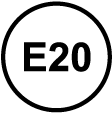Fuel Requirements (SKYACTIV-G 1.3, SKYACTIV-G 1.5)
Vehicles with catalytic converters or oxygen sensors must use ONLY UNLEADED FUEL, which will reduce exhaust emissions and keep spark plug fouling to a minimum.
The vehicle will perform best with fuel listed in the table.
|
Fuel |
Research Octane Number |
Country |
|---|---|---|
|
Premium unleaded fuel (Conforming to EN 228 and within E10)*1  |
95 or above |
New Caledonia, Turkey, Azerbaijan, Armenia, Georgia, Canary Islands, Reunion, Morocco, Austria, Greece, Italy, Switzerland, Belgium, Denmark, Finland, Norway, Portugal, Spain, Sweden, Hungary, Germany, Poland, Bulgaria, Croatia, Slovenia, Luxembourg, Slovakia, Latvia, Lithuania, France, Ukraine, Czech, Estonia, Faeroe, Iceland, Romania, The Netherlands, Macedonia, Bosnia and Herzegovina, Serbia, Montenegro, Albania, Moldova, Martinique, F.Guiana, Guadeloupe, Singapore, Hong Kong, Macau, Malaysia, Brunei, Mauritius, Seychelles, South Africa, Namibia, Botswana, Swaziland, Lesoto, Bermuda, Jamaica, Barbados, Antigua, Guatemala, Bolivia, Uruguay, Honduras, Nicaragua, Aruba, St. Martin, Cyprus, Malta, Ireland, UK, Taiwan, Tahiti, Vanuatu, UAE, Lebanon, Israel, Algeria, Libya, Tunisia, Madagascar |
|
Premium unleaded fuel (within E20)  |
95 |
Thailand |
|
Regular unleaded fuel |
92 or above |
Egypt, Myanmar |
|
90 or above |
Indonesia, Nepal, Sri Lanka, Fiji, Kenya, Tanzania, Mozambique, Trinidad and Tobago, Chile, El Salvador, Costa Rica, Ecuador, Haiti, Colombia, Dominican Republic (LHD), Panama, Peru, B. Virgin, Curacao, The Philippines, Cambodia, Laos, Kuwait, Oman, Qatar, Saudi Arabia, Syria, Bahrain, Jordan, Cameroon, Ivory Coast, Nigeria, Angola, Burundi, Gabon, Ghana |
-
Europe
Fuel with a lower rating will negatively affect the emission control system performance and could also cause engine knocking and serious engine damage.
-
USE ONLY UNLEADED FUEL.
Leaded fuel is harmful to the catalytic converter and oxygen sensors and will lead to deterioration of the emission control system and or failures.
-
The use of E10 fuel with 10 % ethanol in Europe is safe for your vehicle. Damage to your vehicle may occur when ethanol exceeds this recommendation.
-
Never add fuel system additives, otherwise the emission control system could be damaged. Consult an expert repairer, we recommend an Authorised Mazda Repairer for details.




 Read this first
Read this first



















